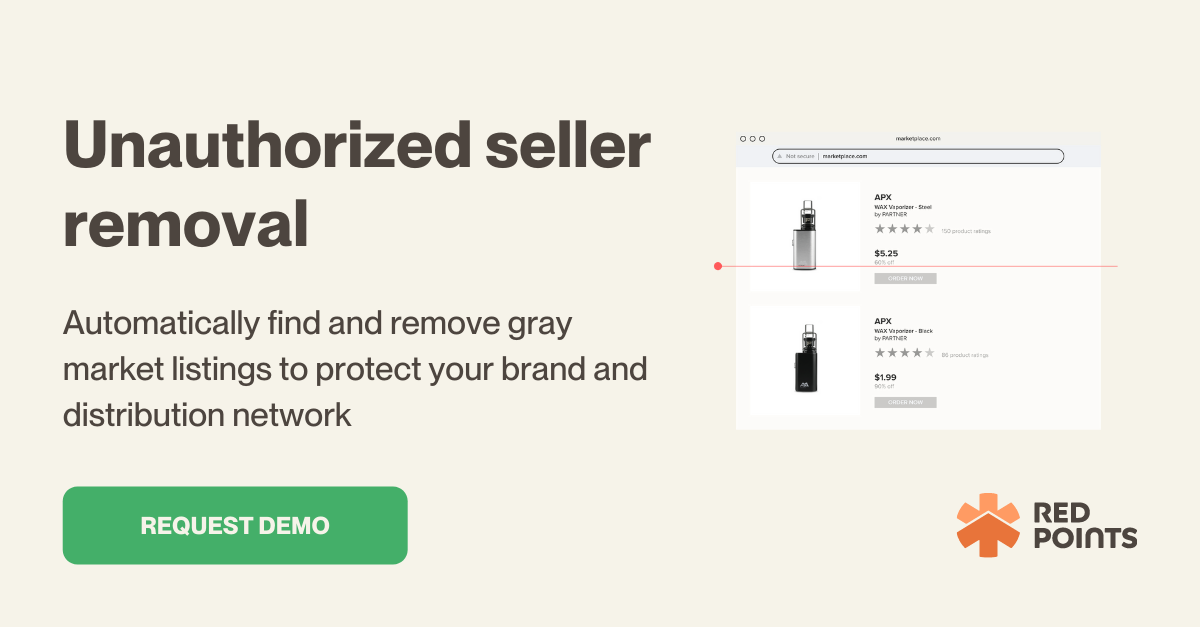Brands and resellers compete for space on Walmart and other online marketplaces. Creating a seller profile and putting things up for sale online is a simple process.
To maintain control over your brand’s image and authenticity, you must identify and stop unauthorized sellers. But you may still find an unauthorized seller that doesn’t adhere to your MAP regulations. Or worse, unauthorized sellers sell a product under your brand that is not affiliated with your network.
In this article, we’ll look at:
- Unauthorized sellers on Walmart
- Walmart’s policies about removing unauthorized sellers
- How to protect your brand’s reputation from being harmed by unauthorized sellers on Walmart
What are unauthorized sellers?
A major concern for businesses selling their products on online marketplaces like Walmart Marketplace is the presence of “unauthorized sellers,” or accounts that purport to be authorized to sell a certain brand’s products.
Products sold by unauthorized sellers are generally of poor quality, which can lead to unfavorable customer experiences or financial losses for the brand. It is illegal for someone or a corporation to sell your brand without having a written agreement with your business.
An unauthorized seller may be doing this in several different ways, such as:
Broken MAP Policy
A vendor advertising your products at a price significantly lower than your MAP is a common scenario. This vendor will show in your list of sellers and stand out owing to the MAP violation as well as the unknown company name if you monitor marketplaces for those who violate the minimum advertised price (MAP).
Restricted Sites for the Sale of Products
If a business wants to manage its brand’s image better, decrease subscription costs, or make it simpler to detect unauthorized sellers, it may not sell its product on sites like Amazon or Walmart. A breach has occurred if your brand does not use particular sites, yet your items are still being offered there.
Counterfeit Products
This kind of resale may be incredibly damaging to your brand because the products being sold aren’t indeed yours, yet they will still cast a negative light on the name of your business. Unauthorized sellers will acquire or develop imitation versions of your products and sell them while using the positive reputation associated with your name.
These products are frequently of poor quality, and as a result, buyers have negative things to say about them. Fortunately, you can protect your brand from counterfeits with the help of technology like Red Points’ Brand Protection Software.

What is Walmart’s unauthorized seller removal process?
Walmart deactivates seller accounts for a variety of reasons. These are listed below:
First Reason: Walmart’s Violation of Performance Standards
Second Reason: Marketplace Retailer Agreement Violation
Third Reason: Ignoring Walmart Operational Standards
Fourth Reason: Violation of Trust and Safety Standards
Sellers on Walmart Marketplace must have a strategy in place to prevent any of the security lapses listed above.
The following sections examine each of these causes for Walmart account suspension in detail.
Reason #1: Walmart Performance Standards Infringement
Sellers must fulfill Walmart’s performance requirements, and Walmart provides a Seller Scorecard so they may keep track of their progress. Four criteria are used to measure if a Walmart employee is meeting the Walmart Performance Standards. Listed below are the details:
1. Cancellation Rate
The percentage of orders merchants subsequently cancel after they have been received from Walmart is referred to as the cancellation rate. Within the next two weeks, it must be lower than 2%.
2. Return Rate
The return rate is the percentage of orders consumers cancel because the vendor sent them the wrong item or it was damaged in transit, for example. In 90 days, the return rate must be less than 6%.
3. On-Time Delivery Rate
It’s the number of orders delivered on time or ahead of schedule. In just 14 days, it should reach a level higher than 95%.
4. Suitable Tracking Fees
The “Valid Tracking Rate” is the percentage of orders with a delivery scan that is on time or earlier than the “Expected Delivery Rate.” These orders have valid tracking information. In just 14 days, it should be at least 99 percent.
It’s not as easy as it seems to provide accurate tracking information. An accurate tracking number and proof of delivery aren’t enough.
Sellers must adhere to Walmart’s Shipping Policy Performance Standards.
Reason #2: Marketplace Retailer Agreement Violations
Creating a Walmart Seller Account involves agreeing to comply with Walmart’s Standard Terms and Conditions, which all sellers must do to complete the process.
Retailer Policies referred to as Terms and Conditions, Policies, and Guidelines in the Agreement, are the rules by which merchants selling on Walmart Marketplace must abide.
A thorough review of the contract is highly recommended. You should also consider inserting any clauses you see that your company could subsequently fail to comply with in your business practice. Don’t sign the contract at all if you don’t have to.
If you break any of the terms and conditions of the agreement, your Walmart account will be suspended. There is no way for us to get out of this situation.
Reason #3: Failure to adhere to Walmart’s operational guidelines
To be successful, Walmart Marketplace sellers must always perform at the top level possible. The most excellent customer service, on-time shipping and delivery, and a return within the time frame are just a few examples.
Additionally, Walmart merchants are bound by a strict price cap to maintain a competitive market position. Operational standards include:
1. Customer Services
Transparency is the key to providing all the information you need to make an informed decision. Customers’ expectations should be realistic to avoid disappointment upon receipt of the goods.
Work with Walmart as a full-fledged business partner and respond to customers’ questions. Don’t be afraid to participate in any training or requests from Walmart for vendors. Follow the guidelines in the letter.
Ensure that you are adhering to the standards by maintaining accurate records and promoting them across your supply chain.
2. Respect people
Walmart sellers shouldn’t use force or child labor. To sell on Walmart Marketplace, vendors must hire based on skill, not race, gender, age, or creed.
Follow current rules governing workers’ pay and hours, and keep up with modifications to preserve their rights. Do not make illegal deductions. Or withhold pay, postpone them, or engage in unfair, unlawful behavior that makes workers’ lives difficult.
Do not discourage or force workers to join unions. Every worker has the legal right to form, join, or aid a Trade Union.
Maintain a safe workplace for all employees and insist they obey all safety rules. Establish clean sanitation, water, and, if needed, food and housing amenities. Always have First Aid and an infirmary with a qualified practitioner available.
3. Become a top Walmart seller
Sellers at Walmart are expected to meet and exceed Walmart’s high expectations at all times. This means that sellers must be aware of the risks and address them to minimize any unplanned or bad events, comply with all laws of fair trade and taxation, and adhere to Walmart regulations.
All third-party sellers who want to sell on Walmart Marketplace must adhere to these rules, and if they don’t, Walmart will suspend their accounts.
Reason #4: Breach of Trust and Safety Requirements
Brands can only maintain customers’ confidence in Walmart’s sellers if they are safe. They must ensure that a legitimate business practice is followed and not challenged by any violations.
As long as they’re selling on Walmart’s marketplace, vendors must adhere to rigorous Trust and Safety Standards or risk having their Walmart accounts terminated immediately.
Among the provisions of these guidelines are the following:
1. Regulatory Compliance
You violate this guideline if you sell a prohibited product on the Walmart marketplace because of the danger to the product and food safety rules. Prescription medications, gambling and surveillance devices, and uncertified and untested infant equipment are examples of this.
2. Offensive Product
Products that promote prejudice, incite violence, or include profanity are examples of things that buyers may find offensive.
3. Intellectual Property
Articles that could infringe someone else’s intellectual property rights on their inventions or anything else that might violate the copyright policy on their intellectual property can be categorized as intellectual property violations. An example of this would be the sale of a painting without obtaining authorization and the right to distribute the work.
What is the Walmart’s Partner Performance Review Team?
Even if one of these rules is broken, the procedure of suspending a Walmart seller’s account is a complicated one. Walmart has a team of specialists to evaluate the performance of its merchants on Walmart.com.
Whenever Walmart’s ODR limit of 2% climbs to a sufficient amount, the company might cancel or restrict the seller accounts of the particular shop. Before Walmart suspends your account, you will receive at least one warning from them. Only those vendors who have been on Walmart for at least three months are at risk of suspension.
Before taking action against a seller, Walmart provides several opportunities to sellers to improve their ODR.
Based on the last 90 days of ODR and the last three months of ODR for sellers with 50 or more transactions over 120 days, the team rates them. When a seller’s limit is reached, Walmart looks back at the ODR data from the previous 30 days to determine whether anything has changed.
Walmart will terminate the seller’s ability to sell on Walmart Marketplace if the sellers still exceed the ODR limit. Walmart, on the other hand, has a fairly equitable system in place. It explains why the suspension was put in place. There are other needs or suggestions for future changes that are also included.
Walmart will inform sellers of any other steps it may take, such as canceling any open orders on your account. They’ll get an email from Walmart letting them know their account has been suspended and giving them a deadline by which they can request it to be reinstated.
Is Walmart responsible for third-party sellers?
Walmart’s Marketplace Promise ensures that your purchases from third-party sellers will arrive on time and in good condition.
Only companies that meet Walmart Marketplace’s requirements can sell on the site. To guarantee that all Walmart.com customers receive the same high-quality service, Walmart employs a rigorous evaluation process that examines the seller’s catalog, operations, financial data, and other relevant factors.
Shoppers who purchase items through the Walmart.com marketplace have access to a single payment method and a secure checkout process. Neither Walmart nor Marketplace vendors have access to your financial information.
Sellers on marketplaces are liable for all aspects of placing and tracking your purchase and dealing with any issues that may arise throughout the delivery process.
You should contact the vendor of the goods you purchased from Walmart Marketplace directly if you have any queries or concerns. The Walmart Marketplace Promise states that if you can’t settle a problem with a Marketplace vendor, Walmart will help you resolve it.
Walmart has the authority to remove certain of your items from their shelves. In certain cases, they do so even if they don’t give a rationale for doing so. When something like this occurs at Walmart, the sellers there are often perplexed by it when it does. Here are a few possible explanations:
- There is a violation of Walmart’s trust and safety guidelines, including the sale of restricted products or product categories.
- Compared to the identical item posted on Amazon, eBay, or other marketplaces under your shop name, the pricing of listings stays relatively cheap.
- Walmart defines low-performing goods as those that don’t generate enough sales. The listing gets removed if they aren’t selling well or isn’t popular with consumers.
- Repeatedly allowing your merchandise to sell out will cause Walmart to remove your listing from their site.
- A product is removed from Walmart’s shelves when it receives many unfavorable customer reviews. It’s easy to see why this is the case. Customers will respond if your goods do not meet their expectations or give a misleading impression that causes them to be frustrated.
How to prevent third-party unauthorized sellers on Walmart?
You must protect your company’s name and reputation. Third-party unauthorized sellers might tarnish your brand’s reputation if your Intellectual Properties are misused, resulting in poor-quality products being delivered to customers.
In the Walmart marketplace, the Walmart Brand Portal helps you protect your brand and your brand image.
To safeguard your brand and intellectual property (IPs) in the Walmart marketplace, Brand Portal is an excellent resource for you. A simple Brand Portal dashboard allows you to manage your brands and intellectual properties easily, claim for any improper activity/misuse of your IPs/brands, and keep track of claims.
The Brand Portal dashboard at Walmart allows you to register as many IPs or brands as you desire. Your trademarks protect your business and they must be registered with the United States Patent and Trademark Office (USPTO) before you can register your IPs on the Brand Portal dashboard.
Walmart does not currently defend trademarks registered with the World Intellectual Property Organization (WIPO) or the European Union Intellectual Property Office (EUIPO).
To register for the Walmart registry or Brand Portal Program, you will need the following items:
- Organization and contact details
- Number of active trademark registrations (Only USPTO)
- An operational email address for verification
Walmart will assess your application for the Brand Portal after you have submitted it and will let you know the outcome.
Another way to prevent third-party unauthorized sellers on Walmart is by employing Gray Marketing Monitoring software like Red Points’. Red Points has helped hundreds of the world’s most successful manufacturers, and brands find solutions to their problems with illegal sales, resolve channel friction, and safeguard their brand equity.
We provide bot-powered searches and advanced image recognition to discover potential infringements for you. This service also includes monitoring and data analytics, foundational policies and procedures, and the ability to request takedowns automatically from the brand protection tool for validated infringements.
What’s Next
Building a successful business relies on protecting your company’s name and reputation. An illegal vendor can use your brand name to sell items or services you legally own. As a result, your company in the Walmart marketplace will be negatively impacted. Because of this, protecting your intellectual property (IP) is a top priority to prevent any fraudulent conduct from infringers.
Sellers are responsible for adhering to the Retailer Agreement and Performance and Operational requirements. As a general rule, sellers should strive to conduct their business in a manner that is both fair and safe for consumers and other sellers. If Walmart’s selling process is too much for your business to monitor closely or if you want to recover revenue lost to unauthorized sellers, then Red Points’ Brand Protection can help.






